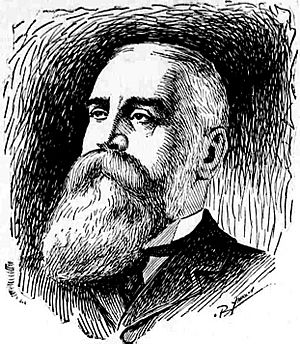Paul Isenberg facts for kids
Quick facts for kids
Paul Isenberg
|
|
|---|---|

Newspaper sketch from 1904
|
|
| Born | April 15, 1837 Dransfeld, Germany
|
| Died | January 16, 1903 (aged 65) |
| Occupation | Businessman |
| Known for | Amfac, Inc. |
| Spouse(s) |
Maria Rice
(m. 1861)Beta Margarete Glade
(m. 1869) |
| Relatives | William Harrison Rice (father-in-law) |
Paul Isenberg (born April 15, 1837 – died January 16, 1903) was a German businessman. He played a big role in growing the sugarcane industry in what was then the Kingdom of Hawaii.
Contents
Paul Isenberg's Life Story
Paul Heinrich Friedrich Carl Isenberg was born on April 15, 1837. His hometown was Dransfeld in the Kingdom of Hanover, Germany. His father, Daniel Isenberg, was a Lutheran minister. His mother was Dorothea (Strauch) Isenberg.
Paul Isenberg moved to the Hawaiian Islands in 1858. He settled on the island of Kauaʻi. His first job there was in Wailua.
Family Life
In October 1861, Paul Isenberg married Hannah "Maria" Rice. She was the daughter of William Harrison Rice. Paul and Maria had two children:
- Mary Dorothea Rice Isenberg (born 1862)
- Daniel Paul Rice Isenberg (born 1866), also known as "Paul Jr."
After Maria passed away, Paul traveled back to Germany in 1869. There, he married Beta Margarete Glade. They returned to Hawaii and had six more children:
- Johannes "John" Carl Isenberg (born 1870)
- Heinrich Alexander Isenberg (born 1872)
- Julie Maria Pauline (Isenberg) Barckhausen (born 1876)
- Clara Margarete (Isenberg) Wendroth (born 1878)
- Richard Menno Isenberg (born 1880)
- Paula Bertha Johanna Isenberg (born 1883)
Developing Sugarcane Plantations
In 1862, Paul Isenberg took over managing the sugarcane plantation at Līhuʻe. He became the manager after his first father-in-law, who managed it before, passed away. The plantation was started by a diplomat named Henry A. Peirce. However, it struggled to make money until William Harrison Rice built an irrigation system.
Isenberg made many improvements to the cane sugar mill. He used special evaporating pans and steam pipes. These helped to make the cane juice more concentrated. In 1872, the Lihue Plantation company became an official business. The plantation was originally about 3,300 acres. It grew much larger, adding another 17,000 acres at Hanamāʻulu.
Role in Hawaiian Government
On January 24, 1874, King Lunalilo appointed Paul Isenberg to the House of Nobles. This was the upper house of the legislature of the Hawaiian Kingdom. At that time, he officially became a citizen of the Kingdom of Hawaii.
In 1877, he bought new equipment for a sugar mill. This equipment came from George Norton Wilcox. Isenberg installed it at Hanamāʻulu. Albert Spencer Wilcox managed this new mill.
Later Years and Return to Germany
In 1878, Isenberg stopped being the plantation manager. However, he still owned part of the business. He moved his family back to Bremen, Germany. Even from Germany, he visited the Hawaiian Islands often. He came at least every two years for important government meetings. His brother, Carl Isenberg, then managed the plantation.
In 1881, Isenberg became a business partner with Heinrich Hackfeld. Hackfeld was another German merchant. Their company was called Hackfeld & Company. Most plantation workers were from China or Japan. But Isenberg arranged for groups of workers from Bremen, Germany, to settle on his company's plantations.
In 1887, there was a big change in the Hawaiian government. A new constitution was forced upon the King. It was called the "Bayonet Constitution" because it was made under threat of military force. Paul Isenberg was one of the few people who spoke out against this forceful change.
Paul Isenberg died in Bremen, Germany, on January 16, 1903.
Paul Isenberg's Legacy
Hackfeld & Company grew to be one of the "Big Five" corporations. These five companies were very powerful and controlled much of the economy in the Territory of Hawaii.
During World War I, the U.S. government took over Hackfeld & Company. This happened because it was owned by Germans. In 1918, a group of Hawaiian businessmen bought the company. They changed its name to "American Factors." The company's store became Liberty House. Later, in 1966, the name was shortened again to Amfac, Inc..
Isenberg's Children and Their Contributions
Paul Isenberg's son, Paul Jr., married Annie Beatrice McBryde in 1891. She was the daughter of a nearby sugar planter. On August 31, 1891, Queen Liliʻuokalani appointed Paul Jr. to her Privy Council. This was a group of advisors to the Queen.
From 1898 to 1915, Paul Jr. was elected as a representative to the House of Representatives for the Territory of Hawaii. He also served in the Senate from 1902 to 1905.
Paul Jr. married Bertha Koepke in 1916. They had one child, Dorothea "Dora" Jane Isenberg. Dora later married Joseph Cole. Joseph Cole became the first manager of the Kauaʻi Museum in 1960.
Paul Isenberg's younger brother, Johannes Friedrich Wilhelm "Hans" Isenberg, came to Hawaii in 1887. He became the pastor of the first Lutheran church on Kauaʻi. This church was for the German immigrants who started arriving in 1881. Hans married his niece, Mary Dorothea Rice Isenberg (Paul's first child), in 1883.

